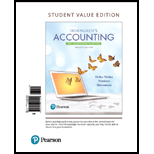
Contribution margin per unit and contribution margin ratio: Contribution margin is the difference between sales and the variable cost. Contribution margin ratio can be defined as the difference between sales and variable cost expressed as the percentage of sales.
The formula used to calculate contribution margin per unit is –
The formula used to calculate contribution margin ratio is –
Break-even point: The break-even point can be defined as the point where the total sales revenue is equal to the total costs involved. The break-even point is calculated as –
Requirement 1
To determine:
Contribution margin per package and Contribution margin ratio
Requirement 2:
To determine:
Break-even point in packages and dollars
Want to see the full answer?
Check out a sample textbook solution
Chapter 21 Solutions
Horngren's Accounting: The Managerial Chapters, Student Value Edition (12th Edition)
- I need this question answer general Accountingarrow_forwardIf 20,000 units are 75% complete with respect to direct materials, then the equivalent units of production for direct materials are: a. 5,000 units b. 20,000 units c. 25,000 units d. 15,000 unitsarrow_forwardaccounting SOLUTION WANTarrow_forward
- - Effects Manufacturing produces a pesticide chemical and uses process costing. There are three processing departments Mixing, Refining, and Packaging. On January 1, the Refining Department had 4,000 gallons of partially processed product in production. During January, 30,000 gallons were transferred in from the Mixing Department, and 30,000 gallons were completed and transferred out. At the end of the month, 4,000 gallons of partially processed product remained in the Refining Department. See additional details below. Refining Department ending balance at January 31 Percent completed for materials cost: 94% Percent completed for conversion cost: 76% What was the total number of equivalent units of production for conversion costs for the month of January for the Refining Department? a. 3,040 units. b. 30,000 units. c. 3,760 units. d. 33,040 units.arrow_forwardGeneral Accounting Question give true answerarrow_forwardA company performed $25,905 of services and received $9,000 in cash with the remaining amount to be paid in 60 days with no interest. What would the effect of this transaction be on the company's current month- end accounting equation? A. $25,905 increase in Assets; No effect on Liabilities; $25,905 increase in Stockholders' Equity. B. $16,905 increase in Assets; No effect on Liabilities; $16,905 increase in Stockholders' Equity. C. $25,905 increase in Assets; $25,905 increase in Liabilities; No effect on Stockholders' Equity. D. $9,000 increase in Assets; $16,905 decrease in Liabilities; $25,905 increase in Stockholders' Equity.arrow_forward
- Give correct option for following data of this general accounting questionarrow_forwardGeneral Accountingarrow_forwardIf an inventory is updated perpetually, which of the equations is correct? A. Cost of goods sold = Beginning inventory - Purchases - Ending inventory B. Cost of goods sold = Beginning inventory + Purchases + Ending inventory C. Ending inventory = Beginning inventory + Purchases - Cost of goods sold D. Ending inventory = Beginning inventory + Purchases + Cost of goods soldarrow_forward

 AccountingAccountingISBN:9781337272094Author:WARREN, Carl S., Reeve, James M., Duchac, Jonathan E.Publisher:Cengage Learning,
AccountingAccountingISBN:9781337272094Author:WARREN, Carl S., Reeve, James M., Duchac, Jonathan E.Publisher:Cengage Learning, Accounting Information SystemsAccountingISBN:9781337619202Author:Hall, James A.Publisher:Cengage Learning,
Accounting Information SystemsAccountingISBN:9781337619202Author:Hall, James A.Publisher:Cengage Learning, Horngren's Cost Accounting: A Managerial Emphasis...AccountingISBN:9780134475585Author:Srikant M. Datar, Madhav V. RajanPublisher:PEARSON
Horngren's Cost Accounting: A Managerial Emphasis...AccountingISBN:9780134475585Author:Srikant M. Datar, Madhav V. RajanPublisher:PEARSON Intermediate AccountingAccountingISBN:9781259722660Author:J. David Spiceland, Mark W. Nelson, Wayne M ThomasPublisher:McGraw-Hill Education
Intermediate AccountingAccountingISBN:9781259722660Author:J. David Spiceland, Mark W. Nelson, Wayne M ThomasPublisher:McGraw-Hill Education Financial and Managerial AccountingAccountingISBN:9781259726705Author:John J Wild, Ken W. Shaw, Barbara Chiappetta Fundamental Accounting PrinciplesPublisher:McGraw-Hill Education
Financial and Managerial AccountingAccountingISBN:9781259726705Author:John J Wild, Ken W. Shaw, Barbara Chiappetta Fundamental Accounting PrinciplesPublisher:McGraw-Hill Education





